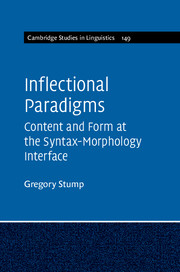Book contents
- Frontmatter
- Dedication
- Contents
- List of figures
- List of tables
- Acknowledgements
- List of abbreviations
- List of symbols and operators
- Introduction
- 1 What are inflectional paradigms?
- 2 Canonical inflectional paradigms
- 3 Morphosyntactic properties
- 4 Lexemes
- 5 Stems
- 6 Inflection classes
- 7 A conception of the relation of content to form in inflectional paradigms
- 8 Morphomic properties
- 9 Too many cells, too few cells
- 10 Syncretism
- 11 Suppletion and heteroclisis
- 12 Deponency and metaconjugation
- 13 Polyfunctionality
- 14 A theoretical synopsis and two further issues
- References
- Index
8 - Morphomic properties
Published online by Cambridge University Press: 18 December 2015
- Frontmatter
- Dedication
- Contents
- List of figures
- List of tables
- Acknowledgements
- List of abbreviations
- List of symbols and operators
- Introduction
- 1 What are inflectional paradigms?
- 2 Canonical inflectional paradigms
- 3 Morphosyntactic properties
- 4 Lexemes
- 5 Stems
- 6 Inflection classes
- 7 A conception of the relation of content to form in inflectional paradigms
- 8 Morphomic properties
- 9 Too many cells, too few cells
- 10 Syncretism
- 11 Suppletion and heteroclisis
- 12 Deponency and metaconjugation
- 13 Polyfunctionality
- 14 A theoretical synopsis and two further issues
- References
- Index
Summary
Canonically, the system of grammatical contrasts relevant to a lexeme's syntax and semantics is exactly the system relevant for the inflectional realization of that lexeme's word forms. In Turkish, for instance, a noun's syntax and semantics involve six distinct case properties (nominative, accusative, dative, locative, ablative and genitive) and two number properties (singular and plural), and a noun's inflectional morphology realizes exactly these properties, as in Table 8.1.
Many languages, however, possess noncanonical systems of inflection in which the grammatical distinctions relevant for a lexeme's syntax and semantics are neither identical nor isomorphic to those relevant for its inflectional realization (Stump 2012, 2014a, 2014b, 2015, Stump: to appear a). In examining content–form mismatches in inflectional paradigms, we have already seen various ways in which the morphosyntactic property set S determining a word form's syntax and semantics differs from the property set M determining its inflectional form. Typically, set S and set M draw upon the same inventory of morphosyntactic properties, a part of the shared vocabulary of morphology, syntax and semantics; but unlike set S, set M may also contain an inflection-class index (Section 7.3). In this chapter, I examine a larger class of properties available to set M but not to set S.
Aronoff 1994 introduces the term morphomic to describe elements of pure morphology, to which other grammatical components are simply blind. A wide variety of phenomena have been recognized as morphomic. See, for example, Cruschina et al. 2013, Maiden 2005, Maiden et al. 2011, O'Neill 2014, and the various contributions to Baerman et al. 2007; see Round 2013 for a particularly detailed account of the richly morphomic agreement system of Kayardild.
Under the assumptions of the paradigm-linkage hypothesis, such morphomic phenomena can all be seen as an effect of properties that are restricted to the level of form paradigms. That is, we can distinguish two types of grammatical properties: morphosyntactic properties, to which morphology, syntax and semantics may all be sensitive, and morphomic properties, to which morphology alone is sensitive. Content cells are pairings of lexemes with sets of morphosyntactic properties; form cells, by contrast, are pairings of stems with sets of properties of which some may be morphosyntactic and others morphomic.
- Type
- Chapter
- Information
- Inflectional ParadigmsContent and Form at the Syntax-Morphology Interface, pp. 120 - 146Publisher: Cambridge University PressPrint publication year: 2015



